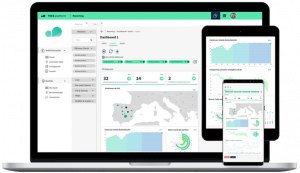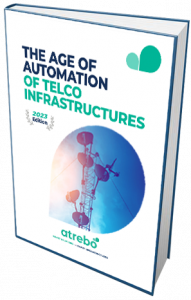The implementation of digital transformation all over the world is boosting the growth of technologies such as Blockchain. Companies are offering a secure solution to improve infrastructure management and Blockchain seems to be the best alternative. At this point, you might be asking yourself, what is blockchain? Read more to find out.
In 2024, it is expected that worldwide spending on blockchain solutions will reach $19 billion, an increasingly significant amount.
“We’re still in the first minutes of the first day of the Internet revolution”
Scott Cook
On the one hand, the Digital Europe Programme 2021- 2027 together with the Next Generation European Recovery funds – this latter accounting for 750 billion of euros –, have provided great opportunities for European organizations to digitalise their processes and overcome the effects of the current challenges.
Based on this digital plan and the increasing investment per year, many public and private companies will accelerate the digitisation process. Digitalisation has not only changed business management, but also the structure of physical products and has even led to the creation of new digital products or services that revolutionise the market. This process is known as technological disruption.
Today, digital technologies are of great importance in organisations and the critical infrastructure is no exception, making use of digital tools to manage its assets.
Every year, infrastructures in industries such as telecommunications are in constant search of process improvement, finding the answer in IT tools. For this reason, we highly recommend you to have a look at our article on the technological trends in the telecommunications industry in what is known as ”emerging telecom technologies”.
Contents:
• What is Blockchain?
• Tokenisation of Inventory Assets with Blockchain
• Benefits of Blockchain in Critical Infrastructure Management
• Product: TREE
What is blockchain?
Once you are aware of the acceleration in investment in digital transformation solutions in 2023 and that blockchain will be a trend this year, you may be asking yourself, what is blockchain?
Blockchain is a shared database that functions as a ledger for the recording of buying and selling operations or any other transaction. Blockchain ” or ”block system” is a basic principle by which all the data recorded through codes can be encrypted.
This principle has great advantages in cybersecurity and the fight against fraud, as it requires the modification of each node of the system that makes up the chain.
Analysing this definition, it may seem too technical, but let’s give an example to make it easier to understand. Are you familiar with ‘‘smart contracts’‘?
Smart contracts refer to contracts that do not require a third party to enforce the contract, but rather individually, digitally and automatically execute the conditions described in the clauses. So if, for example, a person buys a train ticket with a delay insurance and the ticket is delayed beyond the time specified in the purchase contract, a transfer is automatically made and the full amount is refunded.
Tokenisation of inventory assets with Blockchain
After we realized about the potential of Blockchain in the telecom market, we decided to develop a solution to carry out the tokenisation of inventory assets using blockchain technology.
This solution is expected to reach more than 200,000 telecommunications infrastructures. A revolutionary project which is possible thanks to the integration of Atrebo’s TREE platform with Telefónica Tech’own TrustOS managed blockchain platform. But what is this all about?
By integrating these platforms together, we are able to provide infrastructure operators with reliable information in real time and with full guarantee of transparency and traceability.
“Auditing inventory using blockchain technology will be a milestone in the use of digital assets NFTs”
So, once a tower is digitised and created as an asset in TrustOS, the use of blockchain makes it possible to easily certify inventory assets and audit not only its current status, but also the history of actions taken on contracts. In addition, any modifications will be updated following the same process to provide operators with a reliable solution for any asset audit process.
At the end of the tokenisation process, a QR security code will be automatically generated and it will be available in the blockchain platform.
Besides, this platform will allow to record incidences and issues, service levels, traffic data managed by infrastructures and more.
If you are interested in the tokenisation of inventory assets using blockchain, you can read more in our Blockchain Use Case in which you can find a demo video.
Benefits of blockchain in critical infrastructure management
Thanks to Blockchain technology, each block is connected to another one, so there is no need for a centralised database, providing better security, transparency and management.
This technological system allows other technologies such as IoT, AI or Big Data to grow by enhancing the connection between different critical infrastructures, facilitating the automation of processes and increasing data collection.
As a result, operational and asset management efficiency is increased by reducing the time and resources needed to carry them out. In addition, cybersecurity would be reinforced by preventing fraudulent actions and reinforcing the protection of personal data. Indeed, this is one of the great benefits of the blockchain.
But what other benefits of blockchain can be applied to infrastructure management?
• Energy efficiency: As a decentralised network that does not depend on intermediaries, in which transactions are secure and transparent between energy companies and end consumers. This allows energy sustainability and greater control over the energy consumed.
• Smart Green Cities: This is the term given to smart cities that seek to improve the environment of urban cities through digital technologies. By connecting the maximum infrastructures of a city, blockchain can provide the necessary information to control organic waste, urban traffic, energy consumption or to reduce the carbon footprint in the air..
• Better access to the 5G network: Blockchain technology will help devices to have more direct and faster access to the benefits of 5G infrastructures. This will allow users to connect to the nearest infrastructure by constantly seeking the fastest route through the use of tokens.
Discover TREE
Atrebo has developed TREE, an asset management digital transformation platform specialised in process automation and in infrastructure management.
Our mission is to empower critical infrastructure companies by supporting them to take full advantage of the new opportunities offered by digitalisation and by providing innovative solutions in a simple and easy-to-use tool.
We help our clients to improve their critical infrastructure management by transferring our know-how to them. With the help of our solution, your company will be able to increase productivity, digitise processes, reduce operating costs or identify new sources of revenue by adopting a digital strategy, thanks to the knowledge acquired in our 10 years of experience in the industry.


